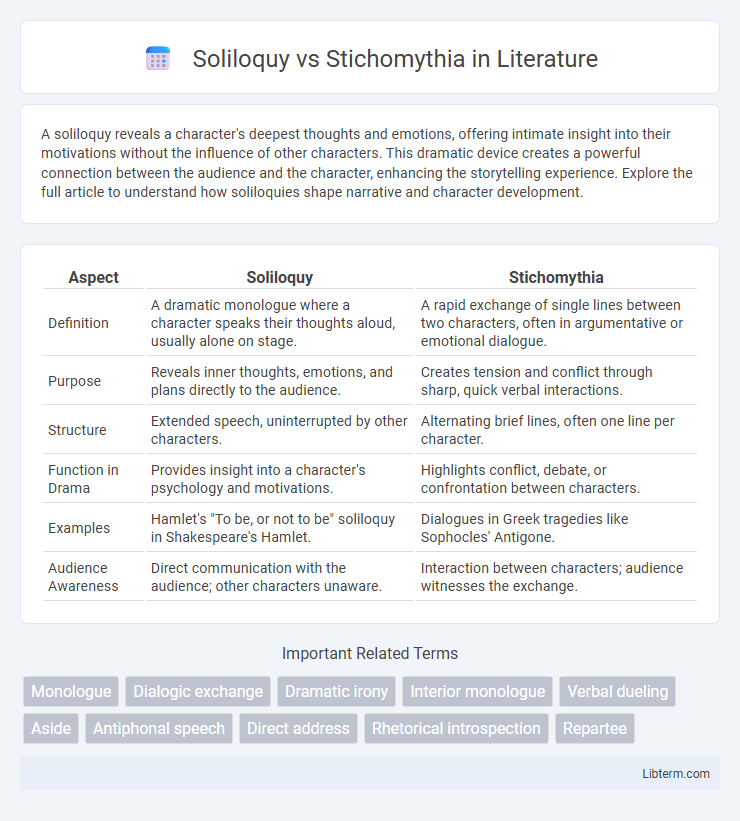A soliloquy reveals a character's deepest thoughts and emotions, offering intimate insight into their motivations without the influence of other characters. This dramatic device creates a powerful connection between the audience and the character, enhancing the storytelling experience. Explore the full article to understand how soliloquies shape narrative and character development.
Table of Comparison
| Aspect | Soliloquy | Stichomythia |
|---|---|---|
| Definition | A dramatic monologue where a character speaks their thoughts aloud, usually alone on stage. | A rapid exchange of single lines between two characters, often in argumentative or emotional dialogue. |
| Purpose | Reveals inner thoughts, emotions, and plans directly to the audience. | Creates tension and conflict through sharp, quick verbal interactions. |
| Structure | Extended speech, uninterrupted by other characters. | Alternating brief lines, often one line per character. |
| Function in Drama | Provides insight into a character's psychology and motivations. | Highlights conflict, debate, or confrontation between characters. |
| Examples | Hamlet's "To be, or not to be" soliloquy in Shakespeare's Hamlet. | Dialogues in Greek tragedies like Sophocles' Antigone. |
| Audience Awareness | Direct communication with the audience; other characters unaware. | Interaction between characters; audience witnesses the exchange. |
Introduction to Soliloquy and Stichomythia
Soliloquy is a dramatic device where a character speaks their thoughts aloud, revealing inner emotions and motivations to the audience without addressing other characters. Stichomythia involves rapid, alternating single-line exchanges between characters, heightening tension and emphasizing conflict through sharp dialogue. Both techniques serve distinct purposes in drama by offering insight into character psychology and intensifying dramatic interaction.
Defining Soliloquy: A Deep Dive
Soliloquy is a dramatic device where a character speaks their thoughts aloud while alone on stage, providing insight into their inner emotions and motivations. This technique reveals the psychological complexity and personal dilemmas of the character, often driving the plot through self-reflection. Unlike stichomythia, which features rapid, alternating dialogue between characters, soliloquy offers uninterrupted, introspective monologue enhancing narrative depth.
Understanding Stichomythia: Key Features
Stichomythia is a dramatic technique characterized by rapid, alternating lines of dialogue between two characters, often used to heighten tension and showcase conflict. This form of dialogue features concise, rhythmic exchanges that emphasize sharp contrasts in opinion or emotion. Unlike soliloquy, which presents a character's inner thoughts spoken aloud, stichomythia is inherently interactive, relying on the quick back-and-forth that reveals relational dynamics and drives the narrative forward.
Historical Origins and Evolution
Soliloquy, originating in ancient Greek theater, evolved as a dramatic device allowing characters to express inner thoughts aloud, prominent in works by playwrights like Sophocles and Shakespeare. Stichomythia, also rooted in classical Greek drama, developed as a rapid exchange of single lines between characters, enhancing tension and conflict during dialogues, especially in tragedies by Euripides. Both techniques transformed over centuries, influencing Renaissance and modern theater's approach to character introspection and dynamic interaction.
Dramatic Functions on Stage
Soliloquy in drama serves to reveal a character's inner thoughts and emotions directly to the audience, enhancing psychological depth and providing crucial exposition. Stichomythia, characterized by rapid, alternating dialogue between characters, intensifies dramatic tension and conflict through verbal sparring and quick exchanges. Both techniques function to advance the plot and develop character relationships, with soliloquy offering introspective insight and stichomythia generating dynamic interaction on stage.
Psychological Impact and Characterization
Soliloquy reveals a character's innermost thoughts, creating deep psychological insight and fostering a strong emotional connection with the audience. Stichomythia, characterized by rapid dialogue exchanges, intensifies conflict and exposes opposing viewpoints, highlighting character dynamics and mental states. Together, these techniques enrich characterization through contrasting introspection and interaction-driven tension.
Dialogue vs. Monologue: Contrasting Effects
Soliloquy reveals a character's innermost thoughts and emotions through a monologue, creating a deep, personal connection with the audience. Stichomythia involves rapid-fire, alternating lines between two characters, heightening dramatic tension and emphasizing conflict through sharp, confrontational dialogue. The contrasting effects of soliloquy's introspective solitude versus stichomythia's dynamic exchange enrich narrative complexity and character development in theater.
Famous Examples in Classical Literature
Soliloquy and stichomythia serve distinct dramatic functions in classical literature, exemplified by Shakespeare's *Hamlet* and Sophocles' *Oedipus Rex*. Hamlet's "To be, or not to be" soliloquy reveals the protagonist's inner turmoil through solitary reflection, while the rapid-fire stichomythia between Oedipus and Creon heightens tension and conflict through alternating single lines. These techniques highlight character psychology and dramatic pacing, integral to classical tragedy and comedy.
Modern Adaptations and Usage
Modern adaptations of soliloquy often integrate multimedia elements and internal monologues to deepen character psychology, seen in films and digital theater. Stichomythia remains prevalent in contemporary plays for creating rapid-paced, tension-filled dialogue that highlights conflict, evident in political dramas and courtroom scenes. Both techniques are reimagined through innovative staging and scriptwriting to engage modern audiences with classic dramatic intensity.
Conclusion: Comparative Analysis
Soliloquy and stichomythia serve distinct dramatic purposes, with soliloquy providing deep insight into a character's inner thoughts and stichomythia delivering rapid, intense dialogue between characters that heightens conflict. Soliloquy reveals psychological complexity and motivates audience empathy, while stichomythia emphasizes the dynamic tension and verbal sharpness in interactions. Both techniques enrich narrative structure but differ fundamentally in their focus on internal reflection versus external confrontation.
Soliloquy Infographic

 libterm.com
libterm.com